How Ignoring Hedging Can Hurt Your Business
Hedge accounting has a reputation as being one of the most difficult areas for people to get to grips with, which is a shame because it is a very useful accounting “technology”.
You can find several articles related to basics of hedge accounting in line with the current rules, for example about differences between fair value hedge and cash flow hedge, or comparing the hedge accounting rules under IFRS 9 and IAS 39.
Today, I’m very happy to publish a guest post written by my Mr. James Philcox, a managing editor at www.appliedIFRS.com who will show you a couple of examples of hedging and use of hedge accounting.
This article reflects the opinions and explanations of James and I must say he is a total hedging geek who really knows his stuff.
Here’s what he has to say:
To illustrate how hedging and hedge accounting can solve real and existing financial reporting problems, let’s take a look at a couple of examples of how hedge accounting is used.
AFS security hedged by pay-fixed interest rate swap
Let us begin with one of the most common hedges used in practice by pretty much every bank that holds Available-for-Sale (AFS) securities as part of its asset liability management portfolio.
We’ll build the example up stage by stage. In Fig 1.1 below, we see regular AFS accounting for a bond. Assuming that it was bought at par and ignoring coupon interest for now, we see the values for the Balance Sheet and Other Comprehensive Income (OCI) as we track the security through 2 time periods.
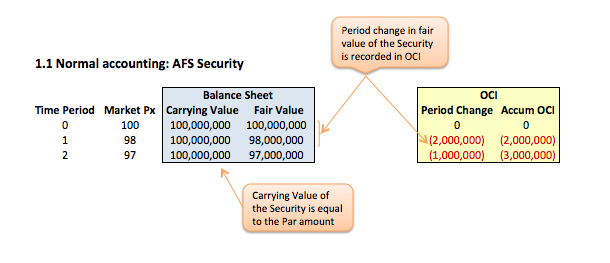
As the price declines from 100 to 97, we record the reduction in fair value in OCI. For the purposes of our scenario let us imagine that these are government bonds, and there has been no reduction in credit quality, instead expectations of future interest rates have risen: as we are holding a fixed rate security, the value of that bond falls as rates rise.
If Management had decided to hedge the bond to counter these falls in fair value and entered into a pay-fixed interest rate swap but did not apply hedge accounting, we can see how that would look in Fig 1.2:
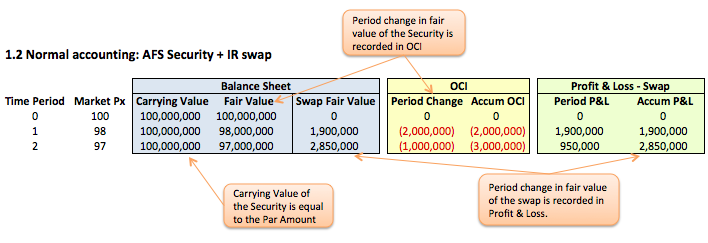
We now have the swap fair value on the balance sheet in periods 1 and 2 and the period gains in value of that swap recorded in Profit & Loss.
However, for Management, this situation is arguably worse than Fig 1.1!
Although the overall impact to shareholders total equity has been reduced, market analysts focus primarily on earnings and we have now increased the volatility of those and introduced derivatives that look like they could be proprietary trading!
The solution is to apply hedge accounting to the AFS security and the interest rate swap, which has the effect of transferring from OCI to P&L the change in the value of the security due to changes in interest rates to offset against the swap:

The fair value of the security is now protected from fluctuations in interest rates and the impact to the bank’s earnings has been greatly reduced.
Forecast future revenues hedged by FX forwards
Another commonplace scenario where hedge accounting can be very useful is in hedging the variability in foreign currency cash flows forecast to happen in the future.
We’ll take a simple example below of a business which received FCU10,000,000 now at time period 0 and an additional FCU10,000,000 at each of the next 2 time periods:
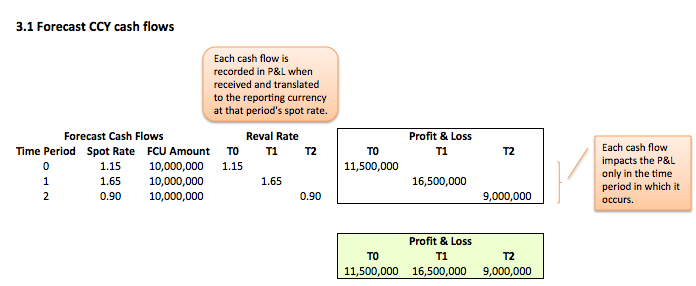
In the above example, we can see that the two future cash flows are each translated to our reporting currency at a different rate. As such, the amount we report in P&L varies quite widely from a high of CU16.5 million to a low of CU9 million.
This kind of volatility in results is something that we usually want to avoid if we can!
To do that we can put some hedges on by entering into forward FX agreements to sell CU10 million at each of the time periods 1 & 2.
There are two critical things to understand here:
- the rate at which we sell forward will be today’s forward rates NOT the actual spot rates in the future; and
- as they are derivatives, the FX forwards will impact P&L at each reporting period until they mature (unlike the cash flows that they are hedging).
We can see what that looks like here:

Let’s put the two together – our future cash flows and FX forward hedges – to see what the combined impact will be:
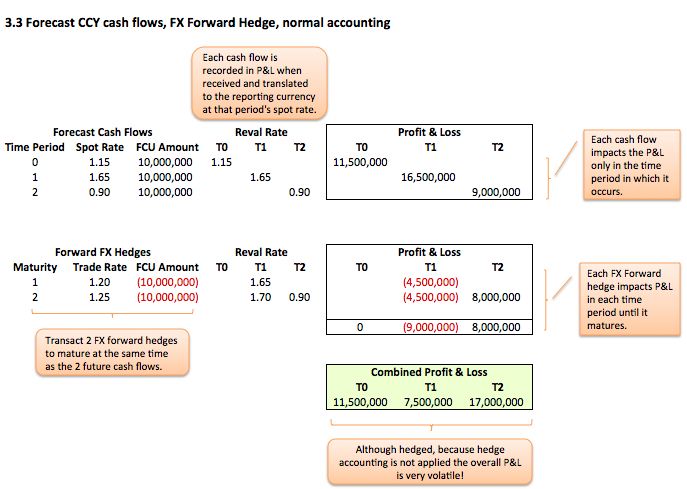
Attempting to hedge our future cash flow volatility from foreign exchange rates in this way has made things much, much worse!
Our P&L volatility now swings from a high of CU17million to a low of CU7.5 million – all for the same underlying economic activity. Obviously, this is completely unacceptable!
The solution, as ever, is hedge accounting!
By designating the FX forwards as cash flow hedges, we can defer the recognition of their fair value changes into Equity (Cash Flow Hedge Reserve) and only recognise the life to date P&L in the period when they mature (offsetting with the cash flow received).

Volatility in the combined P&L is now greatly reduced with a high of CU12.5 million and a low of CU11.5 million.
One important thing to note, applying hedge accounting has not changed the overall P&L that we recognise on the FX forwards, it has only changed the timing of when we recognise it.
As an example, take a look at the hedge maturing at T2. The P&L recognised in that time period is 3.5million. If we quickly look back at Fig 3.3, we can see that the same total P&L was recorded – except it was split between T1 and T2.
This is a critical point to understand as people often get confused and imagine that hedge accounting can turn losses into profits – I only wish that were the case!!
New applications made possible in IFRS 9
The new hedge accounting model introduced in IFRS 9 is a full topic in itself, so I will restrict myself here to emphasising that, fundamentally, what the IFRS 9 model does is expand the scope of hedge accounting – what can be hedged and how we can hedge.
Let’s take a look at arguably the most important of those expansions – component hedging for non-financial assets & liabilities.
Component Hedging
In IAS 39 rules, you can disaggregate a financial asset or liability into its component parts and hedge them individually (as we did with the interest rate risk of our AFS security in the first example above). However, for non-financial assets or liabilities, that is not possible (apart from foreign exchange risk).
Instead, we can only consider the full fair value change in the asset for hedging. To illustrate what this means, let us consider a situation where we are a coffee manufacturer who contracts to purchase coffee beans, the price of which has two components:
- a coffee commodity market benchmark price; and
- a premium reflecting the better quality beans that we want as well as logistics costs (transportation, storage etc).
As the price of beans can vary significantly from one period to the next we want to hedge our future exposure but, while the benchmark component is known and hedgeable, the premium can and will vary from one period to another.
In Fig 5.1 below, we can see what our results would look like:
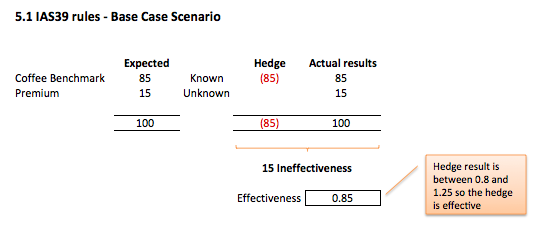
We hedge just the benchmark component, leaving the premium as ineffectiveness. This seems a bit inelegant, but does it matter? After all, the hedge still passes the effectiveness test…
But what happens to our hedge if, instead of being 15, the premium actually costs us 25 by the time of delivery (due to factors that were unforeseen earlier)?
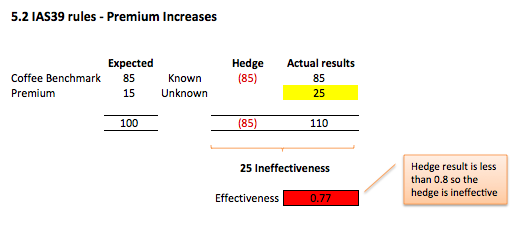
Now we can see that, for only a relatively small change in the premium, our hedge has failed the effectiveness test.
Is there anyway around this? Well, actually yes (sort of). Instead of only hedging the known benchmark amount, we could over-hedge to attempt to compensate for some of the variability of the premium element.
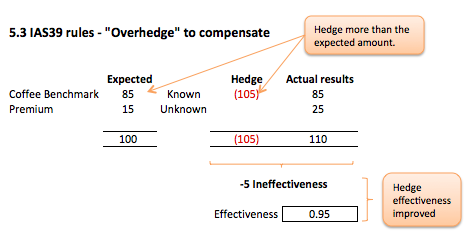
This helps in our example, but it does not solve the underlying problem and we are still vulnerable to fluctuations in the premium causing us problems with hedge effectiveness.
So how does IFRS 9 solve this problem?
In short, it allows us to separate our contract into the two elements that we have been discussing (benchmark and premium) and then assess effectiveness against the benchmark element only:

For hedge effectiveness purposes, as we are comparing the hedge against the known benchmark only, the hedge is perfectly effective. The premium that we pay still goes to P&L (remember what I said earlier about hedge accounting being unable to turn losses into profits) but it now pays no part in the assessment of hedge effectiveness.
This change is important as it brings within the scope of hedge accounting a whole class of commodity based transactions that could not be easily accommodated within the IAS39 model – genuinely making hedge accounting more useful for more people.
About the author
James Philcox is the managing editor of AppliedIFRS.com, a free to access content library on IFRS technical accounting topics, specialising in financial instruments and hedge accounting.
He is on a mission to demystify complex accounting topics, explaining them in original ways using easily understood language.
Did this article help you?
If you know someone who can benefit from reading this article and learn something new about hedge accounting, please feel free to share. Thank you!
Tags In
JOIN OUR FREE NEWSLETTER AND GET
report "Top 7 IFRS Mistakes" + free IFRS mini-course
Please check your inbox to confirm your subscription.
9 Comments
Leave a Reply Cancel reply
Recent Comments
- Albert on Accounting for gain or loss on sale of shares classified at FVOCI
- Chris Kechagias on IFRS S1: What, How, Where, How much it costs
- atik on How to calculate deferred tax with step-by-step example (IAS 12)
- Stan on IFRS 9 Hedge accounting example: why and how to do it
- BSA on Change in the reporting period and comparatives
Categories
- Accounting Policies and Estimates (14)
- Consolidation and Groups (25)
- Current Assets (21)
- Financial Instruments (56)
- Financial Statements (54)
- Foreign Currency (9)
- IFRS Videos (74)
- Insurance (3)
- Most popular (7)
- Non-current Assets (56)
- Other Topics (15)
- Provisions and Other Liabilities (46)
- Revenue Recognition (27)
- Uncategorized (1)

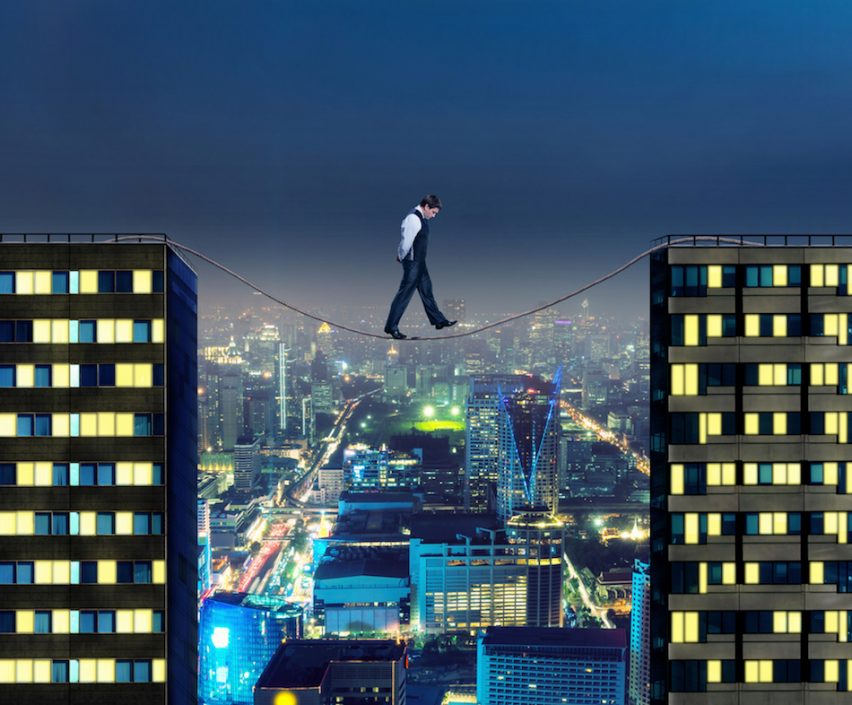



Hi – Could you please state what happens upon dedesignation to the AFS hedge? Would there be an adjustment of the carrying amount of a hedge that needs to be amortized into earnings, or no, because it will continue to be adjusted to full fair value post dedesignation through OCI?
Dear
If we are going to receive Semi Annual installments for five years, and to cover our self against the change in the exchange rate of EUR against USD we have signed 10 FX forward contracts. my question is should we book the unrealized gain / loss from these 10 forward contracts between the change in the spot and the forward rates or this should be done only for the first year 2 installments and not the whole installments. also if you could send us reference for your answer.
Cheers
SHAMS
Hello Silvia,
Good article and unfortunately very challenging for me. I came accross this article because I have been assigned to setout the accounting process for hedging (forward) in the company i work for. As a company, we buy do forward deals for our primary raw materials with a counterparty in USD for lets say 12 months forward looking from now i.e we lock the price and volume. At thesame time, we process the raw material and supply it to our internal customers (backward integration). At the delivery date, a +/- delta is realized and the difference is paid in hard currency. Now i don’t know how to think make all these bookings though i understand the concept. I please need your help or where i can find materials for accounting entries.
Nico
Dear Silvia,
When I tried to look into appliedifrs.com it is empty.
Is it closed?
Regards,
Chandrasekhar
Hi Chandrasekhar, yes, I’m afraid that James closed it. S.
Dear Silvia, most non banking companies in India avail CBLO and enter into OIS to hedge variable or fixed interest rate risk.The hedging is done at portfolio level. Basically word used for doing this transactions is called arbitrage as intention is to play in margins. Whether this transactions would qualify for cash flow or fair value hedge.
realy i am looking for learn IFRS three times faster so please give me in short not
Is it possible to get a discount
Is it possible to pay in some other way, such as the transfer of funds even if the cash via Western Union
Is it possible to pay in installments
I work in the Office of Public Accountants as interest and mutual can deal with you as we are in the search for a professional institutions to be a partner in the business application of international standards for international reporting in particular
If the partner global institution
But did not we study how to deal with individuals
But let’s pass the first stage
They learn IFRS
Dear Khalil,
thank you very much for your interest in my IFRS Kit. However, I will respond these questions in the e-mail, OK? S.
Hi James and Silvia,
Thank you very much for the article. Very good illustration of hedge accounting in practice.
If possible, could you explain a bit about the accounting treatment upon de-designation of hedge?
Cheers,
Nghia